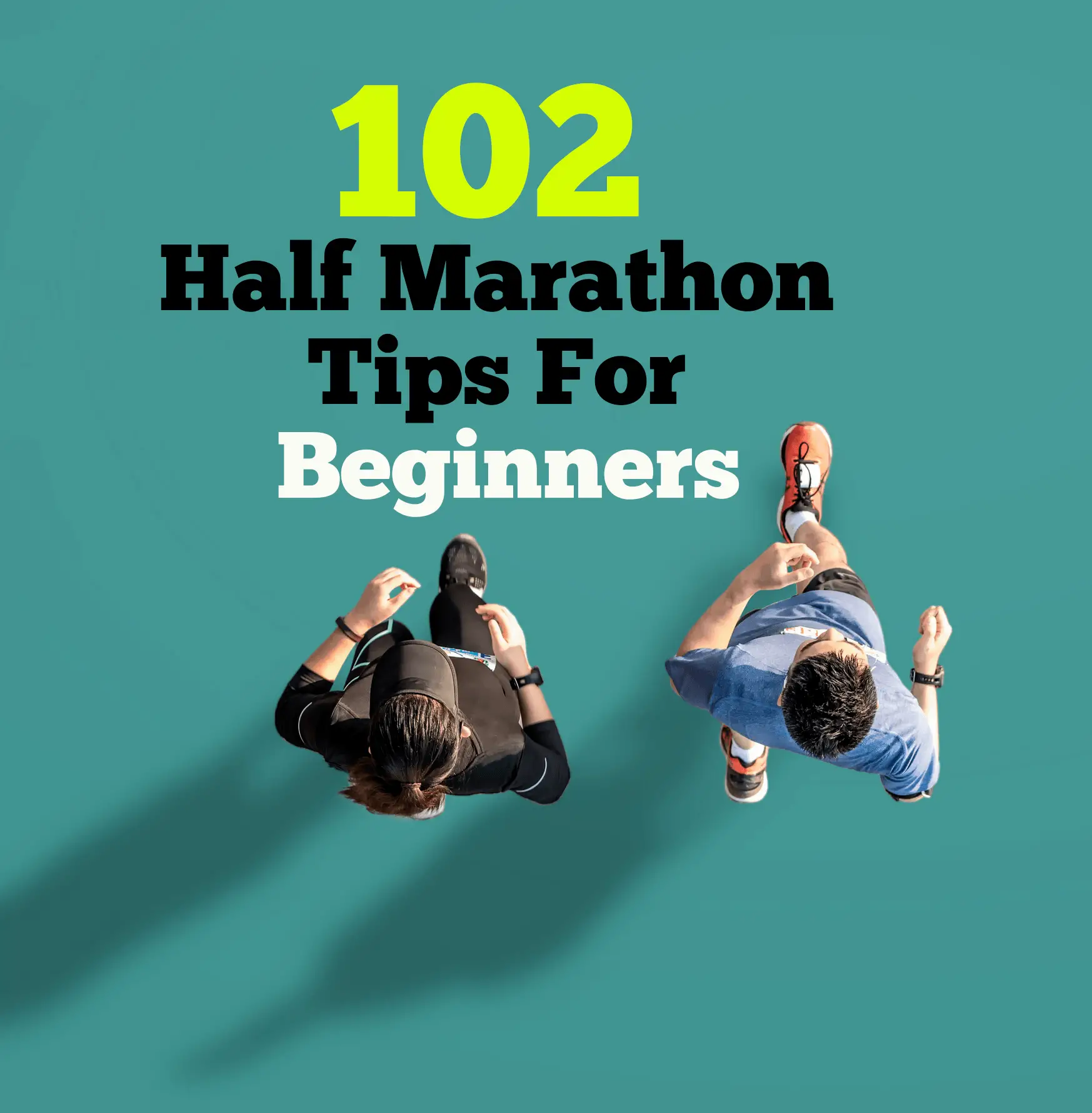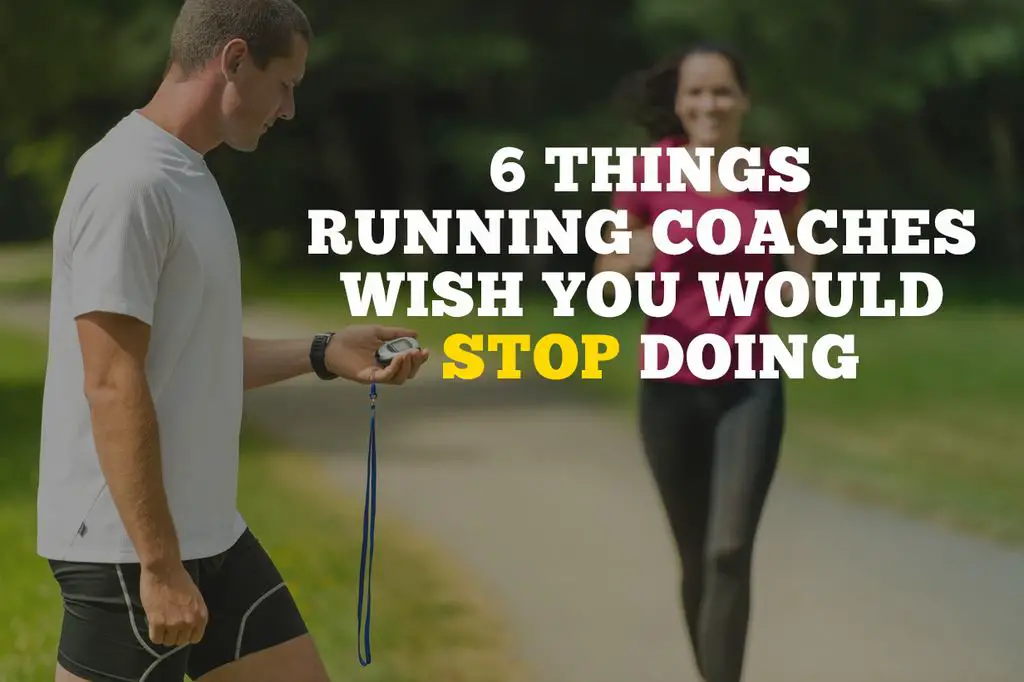Running a half marathon is no easy feat, make sure that you’re ready to tackle race day with these half marathon tips for beginners. First time half marathon runners should primarily focus on finishing the race before the race cut-off times. Here are 102 half marathon tips for beginners to help propel you to the finish line:
1. Take it slow out of the gate
Don’t bust out of the gate at full speed. First of all, you might be able to if you’re in a big race in a big city, such as New York. Secondly, run at the pace you trained to run at. If you’re too fast at the beginning, you might very well screw up the latter part of the race. Save your energy and speed up to your training pace around mile 2 or 3.
2. Take walking breaks when you need to
It’s completely fine to take a break if you need to. Before you try to switch from running to walking, simply try to slow down your running pace. If you still need a break, go ahead and walk for a minute or two. Saving your legs early in the race might be the ticket to allow you to finish the race at a steady pace.
3. Meditate before you race
You don’t have to contort into the lotus position or chant a Tibetan monk tranquility track. Close your eyes for a few minutes and visualize the race you want to run. See yourself crossing the finish line without a problem. Pay attention to how to get it feels when you cross that finish line.
4. Practice affirmations
You want to practice these early on, especially if you’re relatively new to running. An affirmation is the same thing as asserting a fact out loud. These can be simple statements that you repeat daily. I would only choose no more than five. Write them down on a notecard or an app, such as Google Keep. Here are two examples of an affirmation I used during my first half marathon training:
- “I am a runner.”
- “I will complete a half marathon race.”
For emphasis, look in the mirror and say them to yourself – out loud. You need to hear your outer voice, not your inner voice. If someone sees you do it, they might think you’re crazy, just point them to my website and tell them that this crazy coach told me to do it – Ha!
5. Get a Mantra – if you don’t have one, steal these
A mantra is a chant or a quick saying that you tell yourself over and over when your runs become mentally or physically challenging. A mantra is usually some form of words that deal with motivation, determination, or resilience. (3 words every runner should know). An example of a mantra could be something like this:
“Don’t quit, don’t stop.” or “I am strong; I will not fail today.”
6. Get a second pair of shoes
This one is optional, I have run 12 half marathons and countless numbers of 5Ks. I have never trained in two different sets of shoes. The idea behind the second pair of shoes is that your feet don’t get used to one pair of shoes and strengthen the muscles that the other shoe might not. Also, serious runners might need a second pair of shoes to run on different terrain such as a trail, asphalt, and or concrete.
7. Use bandaids to cover nipples during race day
For us dudes, this is a bit embarrassing but this happened to me one time – one time only because I learned my lesson. If you’re running a long race and you sweat a lot, you’re going to want to cover your nipples. The excess sweat and bib (if you have your bib on your shirt) weigh down during the race and cause more friction to be placed on your nipples. Well, guess what happens the next day – ouch! It hurts, and it makes it uncomfortable to wear a shirt.
Related: How To Attach A Race Bib Without Safety Pins
To help prevent this from happening, I now put my race bib on my upper thigh on my shorts, and no more nipple chaffing.
Check out this article for preventing chafing and 5 ways to prevent it!
8. Fuel properly
Improper fueling can make or break a race. Make sure that you have a plan for fuel before race day. Whether you’re going to eat gummies, peppermint, oreo cookies, energy gels, or sports drinks, make sure that you’ve tested it out. Check out this post for an in-depth guide of how many energy gels you should take for a half marathon. If you’re looking for a specific type of energy gel such as gluten-free, all-natural, or vegan, check out my in-depth performance review on energy gels. My goto energy gel used to be GU (which is still my second favorite), but now I use Huma.
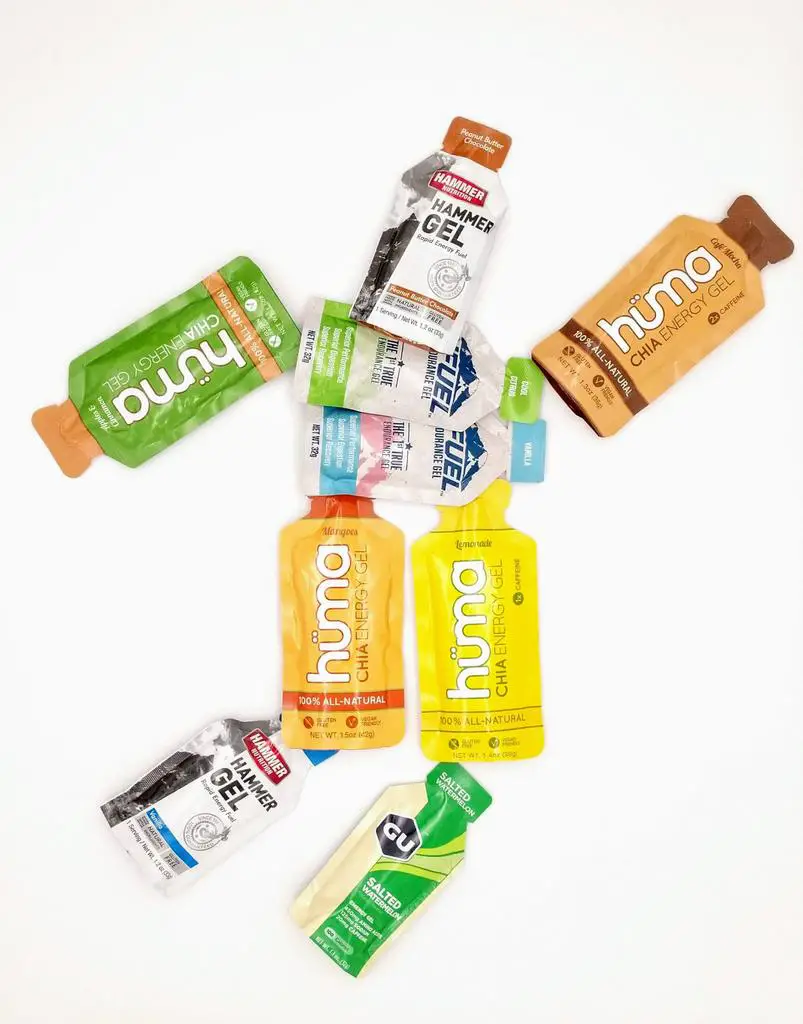
9. Don’t chase a gel with a sports drink – use water
You don’t need the extra sodium, sugar, and potassium if you’re consuming energy gels. Take the gel with water. If you consume a sports drink after every gel, you might be setting yourself up for some severe GI issues later in the race. Water only, please!
10. Start your fueling early in the race
One of the biggest mistakes of my first half marathon is that I didn’t start fueling early in the race. I waited until 90 minutes was up, and then I consumed my first gel. Well, I bonked for about 10 minutes until my gel kicked in, and then I kept fueling about every 30 minutes after that. Start fueling at the 30 or 45-minute mark to help stem off the drop of energy at 90 minutes, and you’ll have a much better race.
Another reason it’s a good idea to start fueling early is that your stomach gets used to eating the gels sooner than later. Racers that often wait too long to fuel can have a serious disagreement with their stomach, which causes the runners to throw up after taking an energy gel.
11. Test your fuel before race day
First of all, you need to test your fueling so that you know what works best for you, gels, candy, sports drinks. Also, you want to find out what doesn’t cause any GI issues before race day. Secondly, you need to simulate race day so that you know what your body feels like when it takes gel for race day. Another reason to test your fuels is so you can train your stomach to eat energy gels on long runs. Just like your feet, legs, and mind need to be trained, so does your stomach.
Related: Why New Runners Quit – Avoid These 15 Mistakes At All Costs!
12. Wear proper socks
Another big no-no for me was not wearing the right socks with my running shoes. I wore the 6-pack white no-show socks from my local giant retailer store. Invest in some good running socks. I purchase 3-4 pairs so that I only need to wash socks once a week. My personal brand of choice is Balega Socks (Amazon Link).
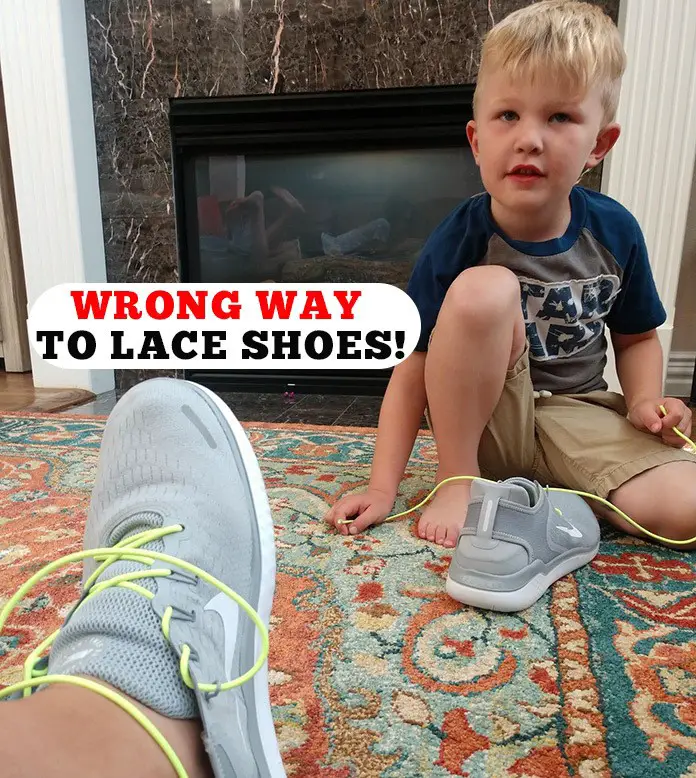
13. Use lace locks to secure your shoes
Don’t let your shoelaces slow you down. Lock laces, by definition, stay locked, and don’t come untied during your run. They are inexpensive and easy to install on any shoe. Check out a short post I wrote about Lace Locks
14. Don’t buy a cheap pair of shoes
If you’re serious about running a half marathon, don’t use cheap, ineffective shoes. There are plenty of good shoes for about $80 and beyond. A lot of websites and companies allow you to try out the shoes for free for 30 to 60 days and return them for free if there are any problems. Zappos (multiple shoe brands), Nike, and Brooks are great places to start shopping for shoes.
15. Get BONUS time to finish your half marathon
If you want more than 4 hours to finish your half marathon, walk or run your half marathon on the same racecourse as a marathon. You’ll get 2 to 3 hours of bonus time to finish your half marathon.
16. Don’t run with your spine straight up and down
Your body was not meant to run with your spine straight up and down. You need to lean slightly forward when you run to prevent all kinds of weird injuries from occurring when you run.
Check out this post for proper running form: Proper Running Form On Flats, Hills, Snow, Sand, and Trails.
17. Don’t run with your head looking at the ground
What happens when you’re head is looking at the ground? You’re breathing inefficiently. Your head should be up looking forward. When your head is up and not in your chest, your air passageways are optimal to remove carbon dioxide and breathe in oxygen in an unobstructed way.
18. Lube up before hitting your long runs
There is nothing worse than a raw burn that sets in after a long-running session. Chaffing can be painful. At a minimum, rub some anti-chafe cream on the inner parts of your thighs. This is the most common location for chaffing. For more info on chaffing, check out this post I wrote about chaffing.
19. Don’t rotate your hips while you run
Your hips should not rotate from side to side. The main reason why your hips tend to rotate from side to side is caused by inappropriate arm form. (basically, your arms are going to high on the forward swing and crossing the center of your torso. Your hips should remain straight when you run.
20. Don’t drink alcohol the night before your longer/harder runs
Alcohol – it’s a love/hate relationship. On your harder or longer run days, try to remain alcohol-free 24 hours before your training session. If you’re hungover, your body is more concerned with expelling your poison than providing optimal energy to your body. This is one of the reasons we feel so sluggish after a hangover.
21. Eat nutritiously
On the way to my first marathon race, I wish someone would have told me this. I was one of the select few marathoners that gained weight while running at a weekly volume peak of about 40 miles of running. Instead of eating more nutritiously, I was needlessly overeating. When you exercise, you burn more calories. I did need more calories; I wasn’t replacing them with the right food.
22. Carbs are not the enemy
If you run, you need carbs. Carbs are the quickest way for you to get energy into your body. You also need to refill your glycogen stores so that you can properly run your longer distances without getting tired. The big problem is that the media has overstated that you need to cut out or reduce carbs. They just forgot to tell you that if you’re an athlete, you still need some form of carbs in your diet.
23. Protein helps repair your body
A great time to get a fix of protein is after a run or in the morning as soon as you wake up. We’ve all heard the wonders of protein shakes, well it turns out that a protein shake here or there could easily benefit your body by helping it repair your muscles much faster than without protein. Especially after your half marathon, eat or drink a portion of protein.
24. If it’s tight, roll it out
After a hard run or long run, use foam rollers or trigger point foam balls to help roll out your tight knots. I use a Trigger Point foam massage ball after every hard run when my legs feel sore. a foam roller can cover your entire legs in one roll, whereas a trigger point foam massage ball targets more specific areas of your legs. Here is a post where I talk about my favorite trigger point massage ball.
25. Get your gait pattern checked out at a running store to find the perfect shoe
Go to your local running store and ask to be fitted for a shoe. Most, but not all running stores, will have a treadmill that you hop on and run for a few minutes on. Some of the more sophisticated machines will help to analyze what your pronation is (for an in-depth post on pronation check out this post: What type of running shoe are you?). Some other stores might perform a video gait analysis or use a foot pressure scan to determine what your gait pattern is.
26. Sunglasses can help block the wind from your eyes
I almost always wear sunglasses when I run, even if it’s overcast skies. The sunglasses help protect my eyes from excessive wind. My eyes tend to water easily, and I find that having an extra shield between the elements and my eyes tends to stop the tears from falling.
27. Smile when you get to the photo ops
Your first half marathon is a once-in-a-lifetime feat. Smile for the cameras and get a photo of you with a half marathon finisher backdrop if they have one. Enjoy the medal. There is nothing like the first time you cross the half marathon finish line. Cherish it!
Are you looking for a great way to display your medals? Check out the post I wrote reviewing the 9 best medal display hangers for runners.
28. Don’t stop at the water station line!
Please do not come to a standstill stop at the water aid station. Follow these rules:
- You can slow down to a brisk walk if you need to
- Move over to the right.
- Grab a cup or two of fluids
- Keeping walking
- After the water aid station feel free to slow down to consume the water.
I’ve run over too many people that grab water and stop right in the middle of the aid station. There is nothing like two strangers’ sweaty bodies colliding, which could have been prevented in the first place, Ewww.

29. If you have to slow down – move to the right
If you have to slow down because of a stitch, aches, pain, please try to move to the right as quickly as possible. I understand that there are times that it’s not that easy, but keep this in the back of your mind.
30. Don’t walk on the left-hand side
If you do, you’ll be in the fast lane. Like the two points above, move over to the right to slow down if you can. The left-hand side will be for faster runners.
31. If you’re slow, do not start at the front of the starting line
If you don’t plan on finishing the half marathon in under 2 hours, don’t start at the head of the starting line. You’re going to make people a little angry. I’ve never gone wrong by starting somewhere in the middle of the muck of people.
32. Practice drinking from water cups while running
If you’re not going to bring your water on race day, practice drinking from a paper cup or water bottle before your race. Giving up a few minutes isn’t going to kill you, so slow down to a walk and drink your fluids. If time is of the essence, you will want to practice this before the race. Should you carry water for a half marathon? – check out this post to help you decide.
33. Don’t change your fuel on race day
This is probably one of the most important tips for a half marathon race. You should have found your goto fuel source prior to race day. Don’t change up the fuel during the race; it could cause a disaster. If you haven’t found a fuel source yet before your race – good luck! Next time before you signup for a half marathon, check out my in-depth posts about fueling for a half marathon and what gear to bring to a half marathon (pre and post-race kits).
34. Don’t change your morning meal on race day
This goes hand and hand with the tip above. Over the course of your half marathon training schedule, you should have been testing your pre-race meals along with fuel for your long runs. I would avoid eating fruits and vegetables (fiber…) for a race meal. Instead, eat something like this. A bagel with peanut butter, maybe an egg or two, and some oatmeal. This meal could range anywhere between 400 and 700 calories. Every racer is different, and fuel requirements vary from runner to runner. Test, test, test!
Are you still trying to figure out what to eat on the morning of your half marathon race, I got you covered right here: What Should I Eat Before A Half Marathon?
35. Focus on enjoying the scenery and the race
Even though I’m going to tell you not to focus on your pace during your half marathon race, you’re going to do just that. I regret not taking it a little easier during my first half marathon. Now, I don’t chase PRs anymore, and I enjoy the fact that I’m able to run for the sake of running. Maybe you can enjoy your 2nd half marathon even more by enjoying the scenery.
36. Don’t focus on a finish time
If it’s your first half marathon, I can’t deny that I did focus on my finish time. To date, it’s still one of my best races that I’ve ever had. Just remember that things could go wrong during your first half marathon if it does don’t fret. Enjoy the race, and finish your first half marathon. There will be another time and place to get better at racing half marathons.
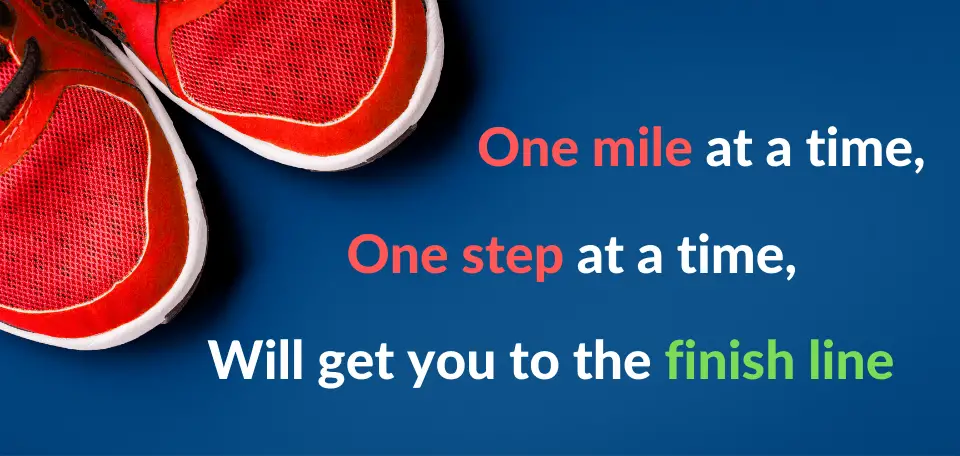
37. Enjoy the finish line, it never gets better than your first-half finish, well except for your first marathon finish!
Don that medal, give high fives to everyone, oh yeah, don’t stop walking for about another 10 minutes. Smile for the camera, strut that stuff, bask in the glory that you have become part of a small pool of people that completed a half marathon. If your legs still hurt after walking for an extra ten minutes. Elevate your legs against the wall with your back on the ground for about 5 minutes. This helps relieve pressure off of your feet and gets the blood flowing from a different position. For a complete list of things to do to make a successful half marathon, check out this post on half marathon recovery. I provide a detailed list of what to do post-race and when to start running again.
38. Celebrate with a beer or two
As my running instructor so quaintly put it, “runners like to drink…healthy.” I think he meant to say a few beers or so. So it’s not the best source of carbohydrates to help to begin to restore your glycogen stores, but I’m not judging. You have to find your “why” for running. We run to help support worthy causes, personal gratification, tick-off bucket lists, and drink a beer or two!
39. Refuel after your race with some carbs
Most races will have some type of refuel food at the end of the finish line area. These snacks range from bananas, apples, muffins, power bars, Gatorade, chicken sandwiches, yogurt, etc. Make sure that you try to eat at least 50 grams of carbs in the first couple of hours after the race. You need to refuel some of your lost carbs as soon as you can. Throw in some protein if you can stomach it after your race.
40. Thank the race volunteers
Don’t forget to thank all of the volunteers at the race to help keep you safe, hydrated, and fueled. When you thank them, they really do appreciate it.
41. Bring a post-race kit
Make sure you pack a change of clothes, any special food requirements, or medical needs to have post-race. Some races will have long walks back to transportation or your parked vehicle, so you might want to check in your post-race kit to pick up after the race for fast access.
42. Bring a pre-race kit
This includes all of your fuel for the race, your phone, GPS smartwatch, earbuds that don’t fall out when you run, bib (if you haven’t already attached it), anti-chafe, sunblocks, sunglasses, headbands, etc. This should be packed the night before so that you can grab it and hit the road fast.
For a compiled detailed list of the best-running watches for half marathon training check out:
Best Half Marathon Training Watches
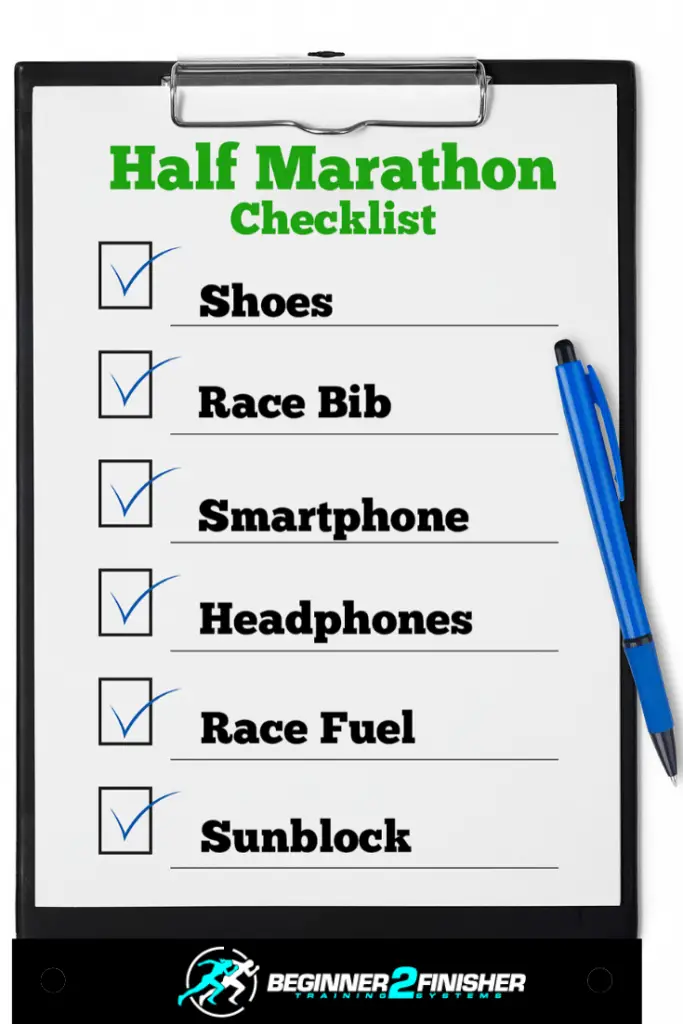
43. Have a race day backup plan
Sometimes races don’t go as planned, especially longer races. If you have a half marathon backup plan just in case things go wrong, it might help relieve a little bit of stress of the race itself. Like what to do if you become winded during your race. Will you shift your running strategy in under to compensate for the change. When I ran my first half marathon, I had a backup plan just in case everything went south, check out my half marathon backup plan post for more insight.
44. Use the restroom before your race
Try to use the bathroom multiple times before the race. I always get a chuckle at how many people are waiting at the port-a-potties on mile two that need to use the restroom. I know some of us can’t help it, so try, try, try to use the restroom before you race.
45. Drink only about 12oz of water before your race
As long as you properly hydrated over the past 48 hours by drinking mainly water and avoiding alcohol, you should probably only need about 12 oz of water to kick off the race. If you’re still thirsty after the 12 ounces of water, continuing sipping water up until the race.
46. Have your family meet you at the finish line
Another great way to enjoy your victory finish, even more, is to allow your family to participate in the after-party. Everyone who loves you wants you to have a traffic race. One word of advice, don’t be a jerk and not tell them your approximate finish time, there is no need for them to get there at the beginning of the race unless they really love you.
47. Avoid fiber the morning of your race
I can stress the “no fiber on race morning” meal plan. I would go as far as not eating any fiber the day/night before the race as well. You don’t want to have to go in the middle of your half marathon.
48. Start in the right race corral – if they have them.
If your race has corrals (runners that have the same approximate finish times), stick with them. That’s the main reason they have the corrals in the first place – to help minimize traffic congestion in the early parts of the race.
Related: What Is A Running Race Corral?
49. Charge your watch/smartphone the night before the race
Don’t forget to charge your tech gear the night before your race. This includes smartphones, GPS watches, and Bluetooth headphones. A race could either be frightening without them or liberating. It depends on the runner and their goal.
Don’t have a smartwatch yet? For a compiled detailed list of the best-running watches for half marathon training check out:
Best Half Marathon Training Watches
50. Cross-train at least once a week during training?
I highly recommend that your cross-training be some form of non-running activity such as walking, hiking, swimming, cycling, etc. Cross-training allows your leg muscles a day to rest while you can still get some aerobic benefits from exercising.
51. My stomach is sloshing around – what is happening?
You drank too much water, and you need to use the restroom ASAP. Running a half marathon with a sloshy stomach is uncomfortable. The one positive note is that you should be properly hydrated for a good portion of the race.
52. Follow a training plan
While running a 5K or 10K can be accomplished with little to no training for someone who is already running, a half marathon takes your endurance training to a new level. For most runners, this is when your long run is introduced. By following a training plan as simple as increasing your weekly long run by one mile each week is far better than following no plan at all.
53. Log your miles
For some of us, there is no way we’re going to forget to log our miles. For others, it’s a chore and feels more like homework. Take the time, at least once a week, to make sure you log your miles. My Garmin Forerunner 235 logs all of my runs to my android phone via the Garmin Connect app so I don’t have to record a single mile.
54. Don’t push yourself too hard too fast
This guidance kind of goes along with don’t start too quickly out of the gate. Run your race at the pace you trained for. Towards the end of the half marathon race, if you feel like speeding up, do so methodically. There is no need to sprint at the end of the race.
55. Your first half marathon isn’t about speed
While some runners will want to include at least one-speed workout and one tempo workout into their weekly training, it’s not necessary in order to finish a half marathon. Speed and tempo workouts are best left for seasoned racers or second-time half marathoners wanting to decrease their chip time. Don’t get caught up in hill repeats, tempo runs, mountain intervals, ladder intervals, and so on. There is plenty of time later to make you faster for a longer sustained time.
56. Make sure that you don’t run for at least seven days after your race
This one is important for the first-time half-marathon racers. Seasoned racers very well might be running a half marathon as a tune-up race, so they don’t need time off to recover. For the first-time racers, wait at least seven days to run more than 5 miles. The day after your half marathon, a recovery run lasting no more than 30 minutes at an incredibly light pace might speed up recovery and reduce soreness. At a minimum, you should still be walking for a couple of miles each day to avoid prolonged pain.
57. The night before your race you probably won’t sleep much
The night before your race, it’s a high possibility that you might not sleep much, you should try to get uninterrupted sleep two nights before your race. The night before your race try to get to bed one hour early to compensate for a restless night of sleeping

58. Try to get your shut-eye in during training
Sleep deprivation will eventually seep into every aspect of your life. When your training for a half marathon, your body will become more tired and need more time to recover from your longer and harder workouts. Take the time to rest and recover properly. Your body repairs and rebuilds muscles when you’re sleeping.
59. If you can’t run it – walk it
If you need to take a walking break during your half marathon race, don’t sweat it. Many runners, at a bare minimum, walk through the water aid stations. This gives you time to walk briskly for a minute and properly drink your water and consume any fuel you might need to. Walking gives your legs a break, especially during the earlier stages of a race. By doing this, you can save your legs for the last portion of the race. Are you wondering if you had to walk a half marathon could you make it before the race cut-off time? If so, I’ve answered your question. Check out this post, Can You Walk a Half Marathon in 4 hours, which includes specific pacing plans to get you to the finish line in under 4 hours.
Are you becoming ambitious with your walking routine, why not find out How Long It Takes To Walk A Marathon.
60. Walk up the hills
Once upon a time, I ran a hilly half marathon. In order for me to complete the race, I ran about halfway up each hill and then walked the rest of the hill to the crest.
61. Run down the hills
What comes up must come down, at least at some point. After walking up the hill and through the crest, I ran down the hill slowly. By alternating between walking halfway up and then running down the hills, I was able to finish the hilly half marathon race more easily.
62. There is no shame in walking some of the race
Once upon a time, if you didn’t run the whole race, then, “you didn’t run the race.” Technically you’re correct. However, we’ve come a long way since the 80s and 90s. There is no shame in adopting and adhering to a run/walk or walk/run strategy to complete your half marathon. It’s an excellent way for beginners to complete half marathons more easily.
63. Write your name on your shirt
For some instant motivation on race day, write your name on your shirt with big, bold letters. When spectators see you run by, they can call out your name and cheer you on! It’s a simple way to get help from the crowds.

64. Don’t skip your long runs
While you shouldn’t try to skimp out on any training schedule run, the one run you don’t want to mess with is the long run. The long-run is what will train your body and allow more glycogen to be stored for longer and longer distances. If you don’t ever run a long run, you’ll never be able to run far distances. Your body must be trained to run longer without excruciating pain.
65. Run for a reason – what’s your why?
Why are you running a half marathon? Are you trying to get in shape? Is this a stepping stone to get to the full marathon? Are you checking this off your bucket list? Are you running a half for the support of another or a charity organization? Finding your “why” can help you power through those darker training moments that we all experience.
66. Lacking motivation?
If you’re having trouble getting motivated to get out of the house and start running, find a running partner. Running partners can help hold you accountable on days that you don’t feel like running.
67. Your easy runs should be easy
Don’t make your easy runs difficult. 80% of your runs during a half marathon training schedule should be relatively easy. For absolute beginners, all of your runs might be 100% easy. If you’re able to have a conversation while you’re running – it’s easy running.
68. Your long runs should be 1 – 2 minutes slower than your race pace
If your predicted race pace for a half marathon is 10 minutes per mile, then your long runs should be anywhere between 11 and 12 minutes.
69. Long runs are about completing the miles, not how fast you completed them
Don’t worry about how long it takes to complete your long run miles or the pace. Complete the miles, relax, and get plenty of rest.
70. Running clubs can help keep you motivated
Running clubs are another great place to get advice on running and training. Some of the better-established running clubs have training programs in place that allow you to train in-house for a half marathon. Check around for clubs located near you.
Related: What is a running club? How can it benefit my running?
71. Need training advice? Find a running coach
If a running club or running partner isn’t working out for advice, it might be time to hire a coach. You can find local running coaches or find them online. Most coaches are going to want you to stick around for a month or so. Some coaches also offer discounted group coaching online.
72. Set realistic goals for your half marathon
This comes back full circle. If it’s your first half marathon, just try to finish the race without injuries. If you know you can run a 5K at a 10-minute pace, then don’t expect that you’ll be able to run a half marathon at a 9-minute pace. Be realistic, and your goals have a better chance of succeeding.
73. Get to the starting line early
Try to get there earlier than you usually would. This allows you some wiggle room if there is extra traffic in the area close to your race. Also, if this is the first time you’ve raced a particular half marathon, you can get the announcements for safety and possible turnaround points in the course. Finally, it allows you to destress a few extra minutes in the starting area before the race begins.
74. Warm-up for 10 minutes before race time
Some runners will jog lightly for about 10 minutes and throw in some dynamic stretching at the end. I’ve seen runners warm up with a 2 mile run prior to a half marathon race. I’ve never jogged more than about 5 minutes lightly prior to a half marathon race. Most of the time, I perform some knee hikes, butt-kickers, side gallops, and a few light lunges to get warmed up.
75. Don’t train every day
Don’t train every day during your half marathon training. You need to throw in at least two rest days for new half marathon runners. On your rest days, you can still cross-train and walk a few miles. What you mainly want to avoid is running again on your rest days. A good 48 hours after a long run gives your body a long time to recover.
How often should new runners be running?
76. If you’re tired, take a rest day
Yes, if you’re tired and you’re supposed to run that day, you can make it a rest day instead. Running, in the bigger picture, is about listening to your body and knowing when you might need an extra day to recover. As long as your still running 3-4 times a week with a long run included, you’ll be just fine.
77. Older runners probably need three rest days
Ok, before I offend many older fast runners, let me further explain myself. If you’re in your 50s, 60s, or 70s, and you just started running, you might need to take three days off a week. One of the days might need to be no exercising at all besides light walking. This totally depends on how active you were prior to running and your overall physical fitness well being.
78. Find another sport besides running – I snowboard and play indoor soccer
Although I indeed love running, I also love coaching youth soccer and playing indoor soccer myself. I also love to snowboard. When I’m on my snowboarding vacation, I don’t run. This is my break from running. I am spending my days hiking to new locations on mountains to ride down and exercising in other ways, such as snowshoeing. When you’re involved in different sports, your body gets to use different muscles in your body, giving your running legs a rest.

79. Wear your race day attire at least once before race day
So you bought a new running outfit to wear during your half marathon race. cool! Did you run in the new outfit before your race? Take it out for a test drive to see how the clothes feel on your body. You don’t want to be in the middle of a half marathon race and realize that something is rubbing the wrong way. Maybe you can swap outfits with a generous spectator in the crowds!
80. Run a 5K during your half marathon training
If you’ve never raced a 5K race, now is the time to race a 5K. I would not recommend running at full-on speed. Instead, race the 5K at a medium to an easy pace. Try to run a 5K early in your training schedule, like the Saturday that you have to do a 5-mile long run. After the 5K, you can run an extra 2 miles and kill two birds with one stone.
81. Run a 10K during your half marathon training
Just like the 5K race, your 10K should be around week 7 or 8 of a half marathon training schedule. Run the 10K on one of your weekends at an easy pace. After crossing the finish line, finish the total number of miles needed for your long run. If you’re supposed to run a 7-mile long run, you need to finish with one more mile. You could also warm up with 1 mile and then finish with a 10K. The choice is yours.
By running 5Ks and 10Ks, you’ll be getting yourself used to the running and racing environment.
82. Wind yourself down during the week of your race
The hay is in the barn. In other words, all of the work you put forth from the weeks of training is about to be unleashed on race day. Any training you do this week should be light. Take the day off before the race and don’t 24 hours before your race. Save your legs for the race.
83. Carb load two nights before your race
So many new runners get this wrong. Carb loading DOESN’T MEAN to eat EXTRA calories two nights before the race. Carb loading means to replace your other portions of food with high-density carbs such as pasta and potatoes. If you eat extra calories in carbs, you could be setting yourself up for some GI issues race day. You’re not trying to stuff yourself. You’re just trying to top off your glycogen stores.
84. Breathe correctly – 3 in – 3 out
Practice your breathing while during your training. As your legs, mind, and stomach are being trained over the course of your training schedule, you need to practice your breathing pattern. If you don’t fully understand this, don’t fret over it. You will grow accustomed to it over time. 3:3 – stands for running 3 steps – breathe in, 3 steps – breathe out. Essentially your deep breathing over 6 steps total.
85. Run at the pace you’ve trained for
When you’re at the half marathon starting lines you’re full of nerves and adrenaline. Too calm yourself down, close your eyes for a few minutes, and just breathe. Tell yourself you’re going to run at the pace you trained for. Naturally, you will run a little faster than the pace you’ve trained at. Your body is full of excitement and it’s hard to quell your feelings. Just remember you’re still human therefore don’t run the race like you’re a superhero with supersonic speed.
86. One mile at a time – one step at a time
Your half marathon race really isn’t one big event. Instead, it’s approximately 26,000 consecutive steps. Take your time and run the race you’ve trained for. Before you know it, you will have crossed the finish line and wonder what’s next. Sometimes after we finish races, we experience what racers call the post-race blues. I’ve written a post that explores a way to avoid hitting the post-race blues during the next few weeks of recovery from a half marathon. Check out the post, How to Beat the Post-Race Blues.
87. When you get to the 7th mile – start telling yourself how many miles you have left.
When you reach your 6th and 7th miles of the half marathon, start telling yourself that you only have 6 miles left (less than half of your race). Follow it up at each subsequent mile:
- 7th Mile – 6 miles left
- 8th Mile – 5 miles left
- 9th Mile – 4 miles left
- 10th Mile – 3 miles left (this is a special mile since you have less than a 5K left)
- 11th Mile – 2 miles left
- 12th Mile – Last mile (another special mile – you should get your 2nd or 3rd wind here)
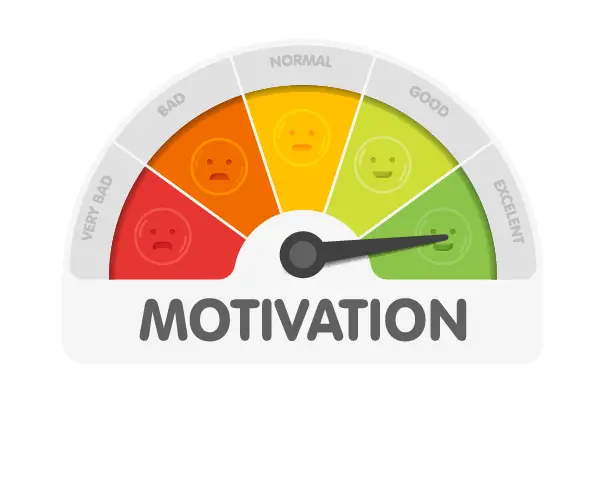
88. After the race elevate your legs for 10 minutes
After you finish the race, try to remain for walking at least 10 minutes (preferably 20 minutes) or 1 mile. If your legs are sore, you can try to gently roll them out with a foam roller or trigger point massage ball. Remember to be gentle if you choose to do this after the race. Find a wall and lie on your back facing with your legs touching the wall. Climb your legs up the wall to about a 45-degree angle with the wall. Lay there for about 10 minutes and relax, giving your legs some much need relief.
89. If you get tired during the race slow your pace down
If you get tired during any part of the race, slow down your pace, if slowing down your pace still leaves you winded or tired then slow down to a brisk walk for a few minutes.
Related: 10 Ways To Improve Your Walking Speed
90. If slowing your pace doesn’t work, walk for a few minutes
When slowing down, your pace doesn’t work. It’s time to walk for a few minutes. In all of my half marathons, I’ve had a few where I didn’t train completely the way I should have, and I found my self in this type of situation. I walked for 10 minutes at one point, consume some fuel, and drink some water. After walking, I was able to finish the race after this good 10-minute walk break. I would rather you do this than entirely stop or give up on the half marathon race. When you stop entirely, mid-race, it’s tough to start back up again.
91. Don’t chase runners that pass you
Ah, the elusive runners that fly by you halfway through the race. Resist the urge to chase after them. They could be an elite runner that started late or worse they could have no idea what they’re doing. I like to pretend they don’t know what they’re doing. You need to stick to the pace you trained for. But what if they were cute? Well, you can always talk to them after the race is over.

92. If someone needs help, stop and render aid
There is normally some time of medical staff somewhere on the racecourse. As a running coach, I have to be hands-on first aid certified every two years. I’ve had to stop only one time to help someone out. A woman had got severe leg cramps on mile 11 about 1/2 a mile from the aid station. This was a small race with minimal runners, and I didn’t have a phone, and neither did she. I ran a 1/2 mile the wrong way and notified the aid station of a woman needing help with her cramps. I ran back by and waited as they arrived in a golf cart and ushered her to the finish line. You never know when you can lend a hand.
Related: Top Items Runners Should Have In Their First Aid Kit
93. Know the race cut off times (and rules)
Hopefully, before you signed up for your half marathon race, you read the rules and race cut-off times. If you’re going to be longer than the cut-off time, you need to ask how they handle runners that are falling behind the race cut-off pace. Some races will pick you up and sweep you from the racecourse. Other racecourses will allow you to finish the race, but full road rules are involved, and they typically want you on the sidewalk for the remainder of the race.
94. Look at the course route before race day
It’s a great idea to look at the racecourse map. I look at the racecourse route with the water stations marked at specific mile markers. The location of the water aid station and the physical amount is a major factor of whether I carry water with me for the half marathon or use the water on the racecourse. I wrote an extensive article on determining whether you should carry water for your half marathon.
95. Check if the race will have pacers
A pacer is someone that runs in the race as a volunteer to keep a specific pace to finish at a specific time. If a race has pacers, consider this a bonus. Find a pacer that is right at your specific finish time or slower. Don’t select the faster pace/better finish time (you’ll wear yourself out). For example, let’s say your predicted finish time is going to be 2 hours and 40 minutes (2:40). The pacers are set in increments of 15 minutes. There are pacers for 1:45, 2:00, 2:15, 2:30, 2:45, 3:00, and so forth. You’ll want to follow the 2:45 finish time pacer. Towards the end, if you’re feeling great, go ahead and speed up and finish ahead of your pacer.
For a detailed post about the pros and cons of pacers checkout:
What is a Pacer and should I follow one on my next big race?
96. Sign up for a flat half marathon racecourse
When you’re selecting your first half marathon racecourse, don’t pick an extremely hilly race as I did. Pick a relatively flat course. It will make your race so much more enjoyable. Plus, you’ll probably finish better than you predicted. If you’re wondering where your first half marathon race should be, check out this post that gives you the insight to determine where you should run your half marathon race.
97. The half is 50% mental, 50% physical
As you’ve figured out by now, the half marathon race is mentally challenging just as much as it is physically challenging. Remember your affirmations and mantras. Find your inner coach and fight off your inner critic. The finish line awaits your arrival, and so does the beer. If you need some extra ammunition to fortify your mind, check out how to trick your mind into running
98. You must take responsibility for yourself
What does this have to do with running a half marathon? More than you think. If you don’t make it to the half marathon finish line, you can only blame yourself. It’s not your spouse, your kids, your job, or lack of time. It’s you. Once you realize that every previous action you’ve taken in your life has led you to this point in your life – yes, reading this blog post right now – I’m not talking about destiny but the actions that guide you towards a goal. Once you realize you’re in control of the ship (your life), you start to see who has been keeping you back in your life – you. One of my first blog posts to this website was titled You Vs. You – Who is going to win. Check it out if you don’t know who is going to win. I want you to win! I want you to feel the rush of triumph when you cross that half marathon finish line!
99. You have to think as a runner would think
You need to become the runner before you’re a runner. In other words, you need to develop a running mindset. The runners who make it to the finish lines are the ones that stayed the course and finished. All runners have bad runs from time to time. Some runners have harder times than others. It doesn’t matter how many bad runs you have, what matters is how quickly you get back up and stare defeat in the face and scream – “Not today!” Every failed run simply a lesson learned, to help ease your post-mortem, check out this post on five questions you should ask yourself after a bad run.

100. Long runs outside
If you’re a treadmill junky – kudos! Make sure that you a majority of your long runs outside to simulate the race day experience. Running on a treadmill versus asphalt is completely different. A treadmill tends to absorb the shock of your foot more so than the hard asphalt. If you run on a treadmill and don’t run any miles on the asphalt, you could be setting yourself up for some serious pain in your legs race day.
101. Indoor tracks
If the weather doesn’t permit you to run outside much during your training, check around to see if you can find an indoor track. Ask and see if you can run just one day a week for your long runs. You might need to change up your schedule so that you take any day slot they might have open. An indoor track isn’t a substitute for asphalt, but at least the surface will be harder than a treadmill.
102. Pretend that you have a magic string
During the race, when runners chase by you, pretend that you have a magic string, and you lasso the string around some part of their body. They are going to give you a free ride. Pull the energy off of them to help reset your mind and recharge your body. I know this one sounds a little quirky, but believe it or not, I’ve used it, and it works.
Another thing I like to do is visually close my eyes for a few seconds when running and imagine that I’m a large space ship running out of fuel, and I spot fuel on the ground, beam it aboard, and refuel my ship. It helps me push out the part of my mind that is telling me that you can’t go on any longer.
103. Use the gear check bag at the race
Gear check bags are great to store all of your post-race activities. To find out the dos and don’ts of gear check bags check out this post – What is a gear check bag and what do I put in it?
104. Don’t forget to strength train
The best way to avoid sustained running injuries is to strength train ( bodyweight, weights, bands, etc.) at least once per week.
Do you need a strength training regime for runners? Check out this detailed post about essential strength training for runners.
Bonus. What is the longest distance you should run before a half marathon?
There are many varying different thoughts as to how many miles you should be able to run before a half marathon race. Check out this post for the answer: what is the longest distance you should run before a half marathon race?
Is it time to retire your running shoes?
If you’ve run more than 400 miles in your running shoes it might be time to consider retiring your running shoes. Check out this post that outlines when it’s time to retire your running shoes –Is it time to retire your running shoes?
| Help support me and subscribe to my YouTube channel. YouTube video - 30 ways to make your runs less painful! Coach Scott's Credentials:
|
To sign up for a FREE half marathon training schedule, log sheet, and pace predictor CLICK HERE.

Recommended gear for runners
Connect with me:
| facebook.com/BeginnerToFinisher/ |
